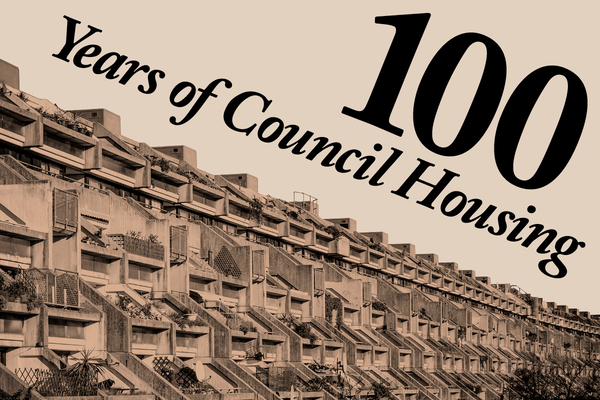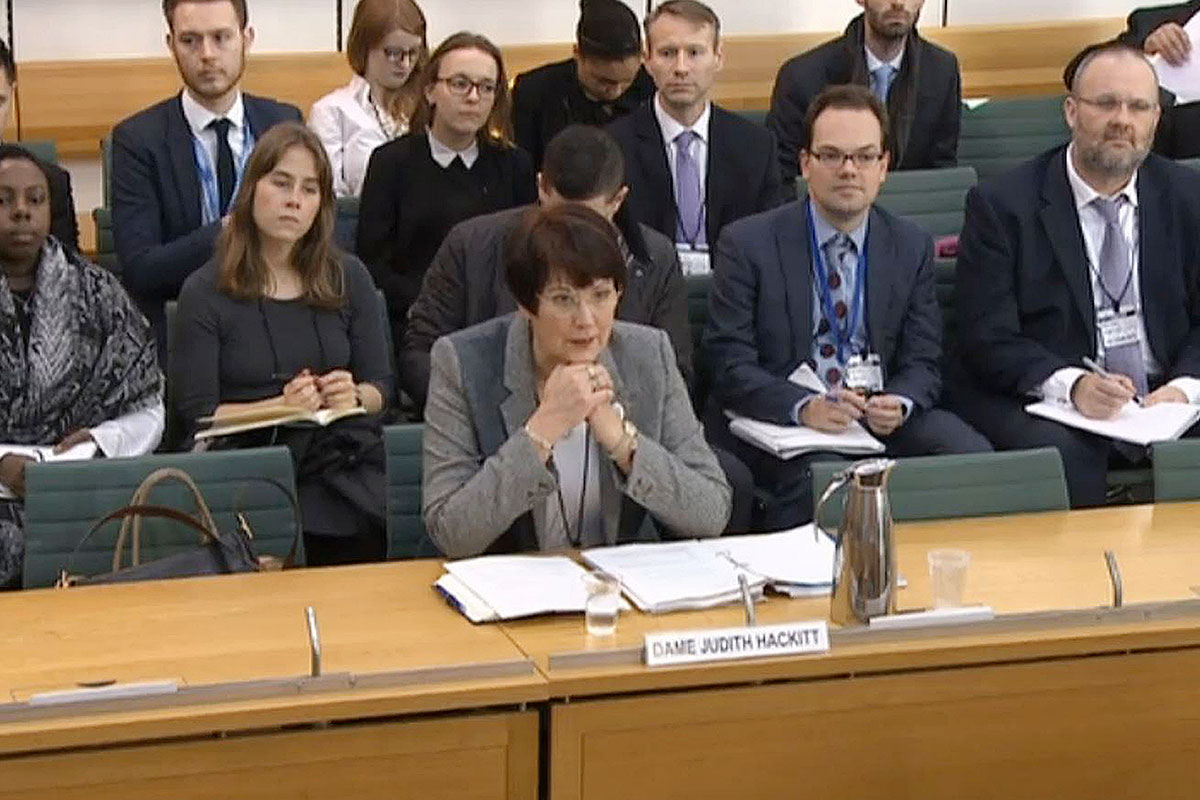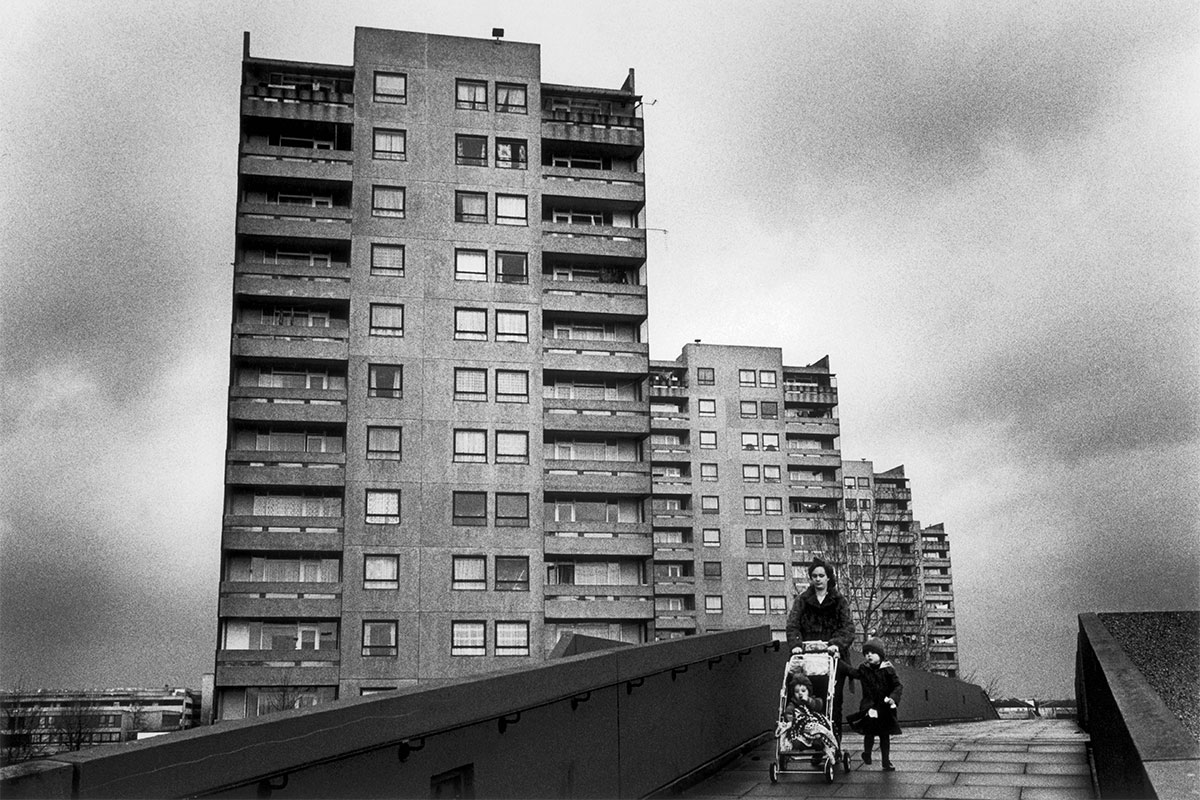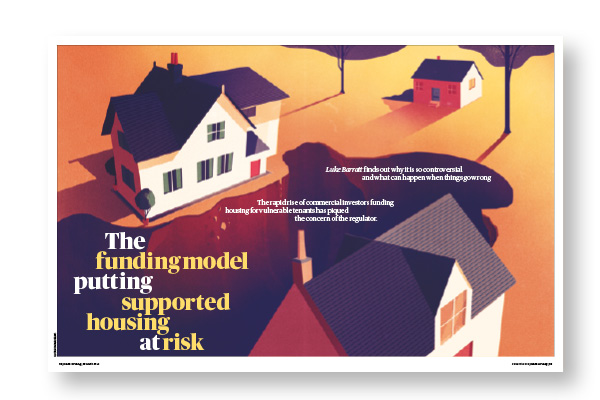You are viewing 1 of your 1 free articles
Review of the year: the key housing stories of 2019
As 2019 draws to a close, Inside Housing looks back at which stories had the biggest impact on the social housing sector this year – from the Grenfell Inquiry and the cladding crisis, to the 100th anniversary of council housing and the rise of for-profit providers. Photography by Press Association, Alamy, GMFRS, Nathaniel Barker and Sonny Dhamu
As 2019 draws to a close it is time to look back on a year defined once again by fire safety and the increasingly difficult climate faced by housing associations as they attempted to balance the books amid cost pressures and falling income.
On a brighter note, this year we ran our 100 Years of Council Housing commemoration – an important reminder of the key role social housing has played in our social fabric over the past century.
Here Inside Housing counts down the key themes:
Financial pressure
L&Q’s head offices in London
Since the Brexit vote in June 2016, uncertainty has shrouded the UK housing market, hitting sale volumes and house prices.
This trend did not stop in 2019. If anything, the uncertainty and the impact on housing associations’ finances got worse.
This was particularly bad for the big developing associations in London and the South East.
In early January L&Q revealed that its surplus would come in £150m short of initial estimates in 2018/19. Others would follow, with some of the country’s biggest associations shaving tens of millions of pounds off their surpluses.
And why was this? Mainly because these associations were unable to sell their private sale homes. This was demonstrated most dramatically in March, when Notting Hill Genesis revealed that it had 400 unsold homes on its books, due to the “massive market slowdown”.
And after the financial squeeze came the reviews and development plan rethinks.
L&Q paused all new developments, while Clarion, Notting Hill Genesis and Optivo were all among the associations that altered their development plans.
But it was not only market uncertainty that was shrinking surpluses. Post-Grenfell, millions of pounds of investment in cladding removal and other remediation works were required on housing association stock.
This could put smaller associations’ business plans under threat, while for larger associations the money has inevitably been taken from the development kitty.
And it is only going to get worse. The G15, the group that represents London’s 12 largest associations, has estimated that it could cost as much as £6.9bn to fix all the issues.
The year has also seen associations putting money towards improving their stock, as the March implementation date for the Homes (Fitness for Human Habitation) law gets closer. Decarbonisation of stock and improving energy efficiency are other areas that associations have had to put money towards this year, and they will need to allocate even more funds towards them in the coming years.
Grenfell Tower Inquiry
Hearings for the first phase of the Grenfell Tower Inquiry closed in late 2018 and the first half of the year became a waiting and guessing game. When would Sir Martin Moore-Bick (above) publish his report and what would he say?
The spring deadline came and went, and in the summer months he revealed that he would not publish it until October – sparking frustration among survivors and the bereaved. There was also some disquiet over a leaked letter that said findings would be limited to the strict events of the night of the fire – despite recommendations from experts for urgent reform in other areas.
When 30 October finally came, the report was initially leaked to the media and a row broke out about whether criticism of the fire service was fair. But when full copies of the 800-page report were finally made available, it looked much more like a balanced and powerful assessment of the terrible events of the night.
Key findings were made about the illegal status of the cladding system installed on the tower and its primary role in the spread of the fire. Sir Martin also zeroed in on failed fire doors and windows that had allowed the kitchen fire to rapidly spread to the cladding.
The recommendations were also wide ranging and will have major consequences for owners of high-rise blocks. Most crucial for the sector were requirements to regularly check fire door self-closers and prepare an evacuation plan for all towers – moving away from the faith that has been put in ‘stay put’ strategies for several decades.
The government has promised to implement all these findings, but quickly after the inquiry’s conclusion we moved into a general election period – putting a freeze on this progress. Social landlords will begin the work themselves, but there are already murmurs of disquiet about the practicality and cost of doing so – estimated to be up to £90,000 a year for a 100-unit tower block.
Cladding crisis
Cypress Place in Manchester, which is having its ACM cladding removed
The story of making existing buildings safe from a repeat of the Grenfell Tower fire is one that has defined every year since the blaze and will continue to do so for many more to come. There have been several strands this year.
First, the slow progress of stripping aluminium composite material (ACM) systems from the 436 towers found to have them post-Grenfell has been regularly chronicled and criticised. At the start of 2019 there were 361 towers in need of remediation work and as it ends there are 318.
Why the slow progress? First, this is complex work and there are limited resources. In April, Inside Housing went to Plymouth to learn first-hand about the issues associated with the removal of cladding from tower blocks. Meanwhile, in the private sector, a row over who should pay put an almost total stall on remediation work.
This blockage, and the unfairness of leaseholders being asked to fund the work themselves in many cases, led to the launch of Inside Housing’s End Our Cladding Scandal campaign in spring. Just weeks later, the government announced £200m for private sector remediation. Shortly afterwards, the government set a deadline of December for the completion of most of the work.
But this has not solved the problem. With red tape tying up applications, the private sector fund has not yet got work moving – and just one block has secured pre-contract approval.
As a result, the End Our Cladding Scandal campaign has stepped up its asks, calling for a taskforce to take control of the work and prioritise and oversee its delivery.
But the cladding crisis was never limited to ACM, and this year issues with other materials have come into much sharper focus. In December 2018, the government published Advice Note 14, calling on building owners to remove combustible materials of other kinds.
The ripple effect of this has been severe – thousands of buildings are now stuck in limbo and surveyors are unwilling to sign off deals until even small patches of combustibles are removed. The crisis has resulted in what one industry figure described as the “complete stall” of flat selling in the UK.
Messages from the government have been confusing. It announced that a combination of high-pressure laminate cladding had passed an official test in July – based on a system that used the most fire-resistant combination possible – but still advised for the material to be removed. It then declined to provide any funding to do so. It has also called for the removal of other materials but is declining to test them.
It has advised the checking of buildings below 18m, but will not bring them into the scope of its combustibles ban or official remediation programme – meaning some 100,000 medium-rise towers around the country are effectively unprotected.
All the while, the year has seen the steady drumbeat of increasingly severe fires in other buildings – many below 18m and all using non-ACM materials. While they have all been non-fatal, there have been serious close calls – and fears have mounted that they are the waymakers pointing to another disaster.
A rising focus on repairs and asset management
For landlords and their tenants there was no more important piece of legislation this year than the Homes (Fitness for Human Habitation) Act. The act, which in fact passed through parliament in the final days of 2018 but only came into force in March, raises the spectre of a glut of claims against landlords as tenants have their hands strengthened when it comes to disputes over maintenance.
Anecdotal evidence suggests that some associations are putting contingencies for claims into their business plans, particularly after the act extends to existing properties next year.
But the act is also just one of a number of potential drains on resources that landlords have been coping with this year. The tougher fire safety measures laid out by Dame Judith Hackitt’s (above) post-Grenfell review of building regulations are already having an impact, with Birmingham Council claiming that its £93m bill will force it to cut corners elsewhere.
Meanwhile, the low-carbon agenda is also forcing a rethink for some, not just in terms of retrofitting existing stock but for new builds as well. In October, the government proposed a raft of green building regulations for homes built after 2025, including the replacement of gas boilers with air source heat pumps.
Associations are already increasing their repairs and maintenance spend, albeit slightly, even while they are having to tighten their belts elsewhere in the face of a housing market downturn. Inside Housing’s exclusive repairs and maintenance tracker found that total spend was up 2.5% in 2017/18. Given that many of the issues the sector now faces when it comes to repairs budgets would have played a smaller role when those results were collated, it will be fascinating to see how landlords react next year.
100 years of council housing
The famous Thamesmead Estate in 1984
To understand fully what 2019 has meant for council housebuilding, we must first cast our minds back to October 2018. At the Conservative Party conference, then-prime minister Theresa May made the surprise announcement that the Housing Revenue Account (HRA) debt cap – which limits local authority borrowing for housing – would be abolished.
Then, we must cast our minds back much further, to 1919. This was the year parliament passed the Housing Act – better known as the Addison Act after the housing minister of the time – commonly recognised as the dawn of council housing as we now know it. The 100-year anniversary saw a widespread campaign to raise the profile of local authority housebuilding.
Newly emboldened councils did what they could to make 2019 a year of hope for those yearning to see a revival of the spirit of a century ago. Sheffield City Council, for instance, doubled the number of homes it plans to build following the scrapping of the HRA cap. Others, such as Nottingham City Council, have significantly scaled up programmes to re-purchase council homes sold through the Right to Buy. Then, a clutch of councils – Liverpool, Peterborough, Bradford and Sunderland – unveiled their ambitions to reopen HRAs, having transferred their housing stock years ago.
Exclusive Inside Housing research published in October found that local authorities intend to quadruple their housebuilding over the next five years, delivering around 80,000 homes.
But it is not just a numbers game. Norwich City Council was widely lauded for its excellent Goldsmith Street development, which won the coveted Stirling Prize for architecture.
All that combined to lead then-housing minister Kit Malthouse to declare council housing “back with a vengeance”.
However, real challenges lie ahead. Councils had a nasty shock a year on from the jubilation of Ms May’s HRA cap announcement when public borrowing interest rates were hiked by 1%, leading the Local Government Association to warn that housebuilding projects may have to be cancelled.
Then there will be other challenges familiar to housing associations. Birmingham City Council – the biggest local authority builder – warned in November that its £93m fire safety bill could even cause it to cut back on repairs. Likewise, Bexley Council recently cut the number of homes in its housing company’s development plan, prompted by the “challenging” housing market conditions.
The continuing rise of for-profit providers
Our feature on the lease-based model
It is fair to say that 2019 has been a busy year for the Regulator of Social Housing. But if there has been one issue that has focused minds most acutely over at the English sector’s watchdog, it is the rise of for-profit associations – and how to handle them.
Predictions of the dawn of a new era of privately funded housing associations have been doing the rounds for some time. But 2019 seems to have been the year when the model went mainstream.
At the turn of the year, the fall-out from the near insolvency of First Priority was still being felt. The regulator was midway through its investigation of five providers of supported housing that used a similar lease-based model to First Priority. Ultimately, all five were found to be non-compliant.
In April, it released a scathing report on the funding model, saying it was “hard to see” how any association financed by long-term leases could comply with either its governance or financial viability standards.
But while the concern over the lease-based funding model has been a running sore for the regulator, the commercialisation of the sector is very much here to stay.
Examples of privately backed for-profits teaming up in management deals with established associations were sprinkled throughout 2019.
In January, Blackstone-owned Sage Housing joined forces with Places for People, with the latter in line to manage the 20,000 homes it plans to build over the next five years. And towards the end of the year, investment giant Legal & General named the 14 associations it hopes will manage its social housing portfolio.
The entrants of ‘for-profits’ also included a flurry of new registered providers set up by private house builders – primarily to allow them to hold on to Section 106 homes developed on their schemes.
The rise of these players has raised important questions about the role of private profit in the sector – and what the future shape of the sector will look like should these fledgling organisations continue their rise.
Around the UK
New Lodge in north Belfast, an estate owned by the Northern Ireland Housing Executive
Northern Ireland
As Northern Ireland witnessed another year of political stasis, three major ongoing housing issues continued.
The Northern Ireland Housing Executive remains in the grips of a severe funding crisis – Inside Housing revealed that outstanding repairs have risen significantly at the 85,000-home landlord over the past three years.
Meanwhile, Brexit delays at Westminster mean that the sector is still waiting for legislation that would save housing associations in Northern Ireland from being reclassified as public bodies.
Finally, mitigation payments, which insulate Northern Ireland from the bedroom tax and the benefit cap, will end in March, with tens of thousands of households set to have their income slashed.
Scotland
The Scottish sector has continued to work towards the government’s target of delivering 50,000 affordable homes by 2021. However, as the sector looks beyond the deadline, many fear that a drop in funding is on the horizon.
In Glasgow, the plight of asylum seekers continued. Last month, Scotland’s highest court ruled that Serco’s policy of evicting failed asylum seekers without a court order was lawful.
Meanwhile, Glasgow City Council continued to fail to meet its homelessness duties. In August, Shelter announced plans to take the council to court over its failings, and last week the Scottish Housing Regulator launched an inquiry into Glasgow’s homelessness service.
Wales
The Welsh government ended 2018 by announcing that social rents could be raised only by inflation in 2019/20. This had an adverse impact on landlords, with councils forced to cut £2.7m from their HRA plans.
In May, the highly anticipated Independent Review of Affordable Housing Supply was published. Ministers accepted all but one of the review’s recommendations, which included the introduction of a five-year rent settlement and grant funding reform.
The housing sector now awaits the announcement of the five-year rent settlement, originally scheduled for July. It is now expected that the policy will be announced following this month’s budget.
More on the Addison Act
How George Clarke is aiming to end the housing crisis with his new TV show Architect George Clarke has long been a passionate campaigner for more – and better – council housing. As Inside Housing celebrates 100 years of the Addison Act, Martin Hilditch meets a man on a mission
100 Years of Council Housing: your tweets from week three Our favourite #100yearsofcouncilhousing tweets from the past seven days as our Addison Act activity moves into its fourth week
Nottingham's new wave Robyn Wilson goes to Nottingham to see what the next generation of council homes are set to look like.
If we’re going to have another 100 years of council housing, Right to Buy has to go The Right to Buy is having a devastating effect on the availability of council housing in this country and must be scrapped, writes Lee Sugden
What next for council housing? To celebrate the centenary of the Addison Act, Inside Housing asks a group of housing experts what can be learned from its legacy (sponsored)
Thatcher's legacy: a brief history of the Right to Buy An engine for social change or a handbrake on council development? We look at why the Right to Buy is as divisive as ever #ukhousing
A history of council housing: a timeline From the Addison Act to prefabs, slum clearance and the Right to Buy, council housing in the United Kingdom has a long and colourful history. Carl Brown looks at how it has evolved over time
Council housing: the key to a more equitable and dynamic society As the 100th anniversary of the Addison Act approaches, we publish an abridged extract of a book by Chris Matthews chronicling the history of council housing in Nottingham
Addison’s framework was scrapped but its legacy is more important than ever The fortunes of council housing have ebbed and flowed ever since Addison’s programme was abruptly halted in 1921, writes Jules Birch
Hulme: the redevelopment project that changed regeneration The redevelopment of Hulme in Manchester kick-started a new approach to regeneration in the UK – and the careers of some of housing’s best-known figures. Martin Hilditch joins them on a step back in time with lessons for today.
100 Years of Council Housing: your tweets from week two We pick our favourite #100yearsofcouncil housing tweets over the past week
Memories of council housing: the human legacy of the Addison Act As the centenary of the first council houses approaches, Peter Apps hears from some of the people who have lived in them in the decades since
Many of the sector’s current leaders began their journeys in council teams One hundred years of council housing has delivered a generation of sector leaders as well as millions of council homes, writes Mervyn Jones
Stevenage: home of the new town revolution Stevenage was the first of the post-war ‘new towns’. Gavriel Hollander visits the town to see how it has changed.
100 Years of Council Housing: your tweets from week one Inside Housing has been encouraging councils to say what they are doing to build homes and to mark 100 years of council housing. Here we feature a selection of your tweets
Kit Malthouse: 'Council housing is coming back with a vengeance' Housing minister Kit Malthouse tells Martin Hilditch why growing numbers of councils are looking to get back into development
Sea Mills: we visit one of the first estates to benefit from the Addison Act Social historian John Boughton visits a place in Bristol still cherished today
The Housing Podcast: is council housebuilding about to make a comeback Nearly 100 years after the introduction of the Addison Act, which kick-started the building of the first council estates in the UK, the Housing Podcast team examines the state of council housebuilding today
Why the 100th anniversary of the Addison Act should spark a council housing comeback Let’s make 2019 the start of a renaissance of council housing, writes Martin Hilditch
Are new borrowing freedoms sparking a revival of council housebuilding? The Addison Act marked the birth of council housebuilding. A century later, could recent financial freedom spark a renaissance? Nathaniel Barker investigates.
How Cornwall is taking inspiration from Christopher Addison Cornwall Council is one of many keeping the legacy alive, writes Kate Kennally.
The Addison Act - celebrating 100 years of council housing This year marks the 100th anniversary of the Addison Act – which paved the way for council housebuilding on a large scale. Inside Housing has a whole month of special activity planned and we want to hear your stories
The 100-year anniversary of the Addison Act means it’s time to talk about council housing Let’s use the 100th anniversary of council housing as we know it to flag up some of the great work that’s been done – and kick-start a conversation about the future, writes Martin Hilditch
London must recapture the housebuilding ambition of the Addison Act Councils are committed to development but are still facing unfair restrictions, writes Darren Rodwell of London Councils
Marking 100 years since the ‘Addison Act’ Professor Mark Swenarton writes about the Homes Fit for Heroes Centenary Conference
End Our Cladding Scandal: full coverage
- Government-funded advice agency tells leaseholders they are 'likely' to be liable for cladding costs: LEASE, the government's official advisory service for leaseholders, has been advising residents they are likely to be liable to pay bills for cladding removal
- Residents evacuated after fire at block with Grenfell-style cladding: Residents of Vallea Court in Manchester are forced to flee after a fire breaks out in a lift shaft
- Leaseholders in London block pay nearly £3.5m for cladding removal: Despite promises from ministers to protect leaseholders, residents of the M&M Buildings near Paddington have been told to pay out
- Minister's will have blood on their hands if another death occurs, says MP: A round-up of the parliamentary debate on providing funding to remove dangerous cladding
- Sector leaders call for an end to the cladding scandal: backers of the campaign explain why they are calling on the government to end the scandal
- #EndOurCladdingScandal – campaign launch sees cladding stories go viral: a round-up of the Twitter reaction to the launch of our campaign
- Revealed: the mental health trauma of residents in blocks with dangerous cladding: read about the mental health impacts of dangerous cladding on high rises
- Victims of the cladding scandal: read the stories of some of those impacted by the crisis
- Why we need a cladding fund for private buildings: Manchester Council chief executive Joanne Roney explains why a fund to pay for cladding removal is necessary
- Why Inside Housing is joining with leaseholders to call for an end to the cladding scandal: our deputy editor Peter Apps on why we are supporting the campaign
- End our cladding scandal: the campaign’s aims and backers











